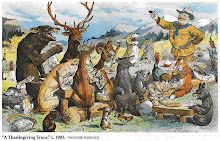Judge rules polar bears still 'threatened'
The polar bear was the first species added to the Endangered Species List solely because of the threat from global warming. The status of polar bears became an issue in 2005 after the Center for Biological Diversity, Natural Resources Defense Council and Greenpeace filed a petition arguing that shrinking ice impaired the bears' ability to catch prey and could lead to their extinction. In December 2006, then-Interior Secretary Dirk Kempthorne declared the bears "threatened," rather than endangered and in imminent danger of extinction. Endangered and threatened species receive the same protections, such as protection of critical habitats, population recovery assistance and prohibition of harm to the species or its habitat. For threatened species, however, the government can reduce protections or allow exemptions.
If the bears were listed as endangered, new power plants could be blocked, as well as other sources of carbon dioxide and other gases that contribute to global warming. It also could make petroleum exploration more difficult. As a result, Kempthorne created a "special rule" stating that the Act would not be used to set climate policy or limit greenhouse gas emissions, pesticides, mercury and other pollutants outside of the Arctic that harm the bear. The Obama administration upheld this policy.
The state of Alaska and hunting groups argued that the listing was unnecessary because the bear is protected by other laws.
"With the population of the species in decline, the needless hunting of them for sport must not be an option," said Jeffrey Flocken, D.C. Office Director, International Fund for Animal Welfare. "As pro-trophy hunting organizations continue the fight to skirt existing laws and import polar bear trophies, today's decision serves to reinforce the fact that the species is in jeopardy. The short-term special interests of hunting groups must never take precedence over long-term conservation efforts for the protection of polar bears."
Currently, conservation groups are challenging Kempthorne's special rule in court. "This decision is an important affirmation that the science demonstrating that global warming is pushing the polar bear toward extinction simply cannot be denied," said Kassie Siegel, director of the Center for Biological Diversity's Climate Law Institute. "While we are disappointed that the polar bear will not receive the more protective endangered status it deserves, maintaining Endangered Species Act listing for the polar bear is a critical part of giving this species back its future."
Studies show that rising temperatures are quickly melting the Arctic sea ice, forcing polar bears inland. In September 2007, scientists at the U.S. Geological Survey released a comprehensive nine-volume analysis of the science and reached a dire forecast: Two-thirds of the bear's habitat would disappear by 2050.Polar bears are experts at hunting ringed seals and other prey on sea ice. But they are so unsuccessful on land that they spend their summers fasting, losing more than 2 pounds a day. Overall, scientists believe the global population of 20,000 to 25,000 polar bears remains robust. But virtually all polar bear experts predict rapid population declines in the Arctic, which is warming faster than anyplace else in the world, changing too rapidly for the bears to adapt and find another source of food.









No comments:
Post a Comment